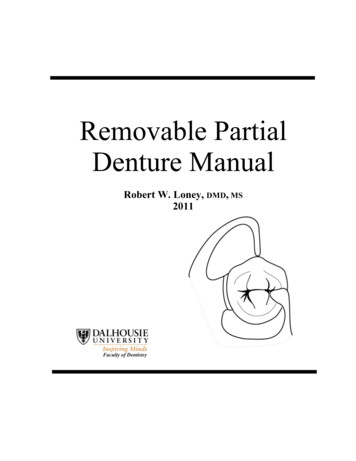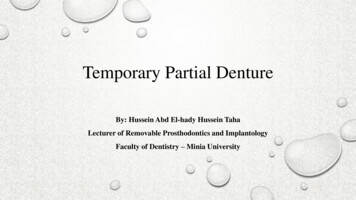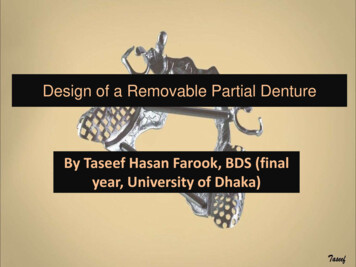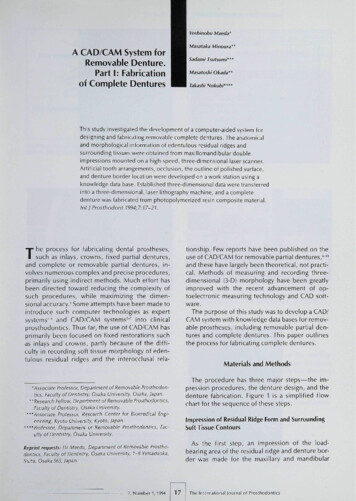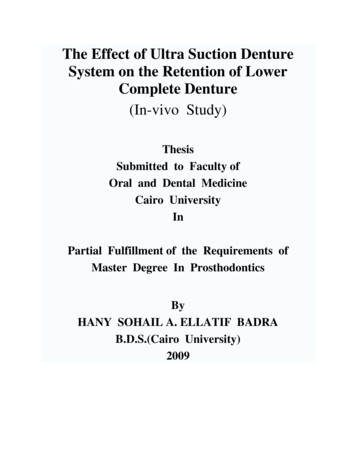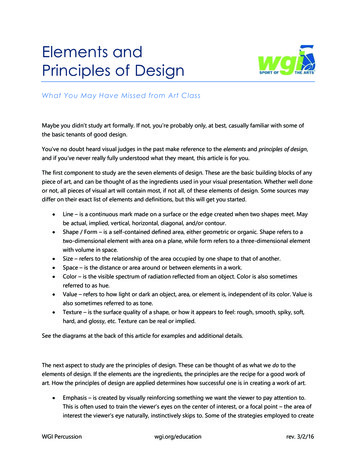
Transcription
Principles of Partial Denture Design1. Keep the RPD design as simple as possible“Simple”— those design elements whichpromotefunction,esthetics, comfort, ease of fabrication, and ease of maintenance,cleaning,and repair. Example of simplification the design is toeliminate anterior modification spaces.2. Eliminate anterior edentulous spaces by fixed partialdenture.Simplify the RPD designEliminate the technical difficulties of placing anterior prosthetic teethon an RPD.3. Eliminate all but one posterior edentulous space perquadrant.Using fixed partial denture to simplify the RPD design.Eliminate the technical difficulties of restoring multiple edentulousspaces in one quadrantEliminate the potential destructive forces on lone standing distalabutment teeth.Prosthodontics 3rd yearDr. Rola Shadid
Recommended to splint the lonestanding abutment to anteriortooth by bridge4. When other dental treatment is planned, and an RPD will bemade at the end of treatment – ALWAYS PLAN THE RPDFIRST. You will see which abutment modifications will be needed, andwill ensure the planned RPD is feasible, prior to beginning treatment.5. Utilize what's present. Whenever possible, select a design that fits theteeth and soft tissues, rather than choosing one that requires tissuealteration. When minimal tooth recontouring is required, surfaceroughness is minimized and teeth will be less susceptible to plaqueadhesion and subsequent caries. Minimal preparation may also provide aneconomic advantage to the patient (e.g. if crowns are not required). Thegoal is to avoid gross, unnecessary preparation but not to avoid essentialpreparation. For instance, when recontouring of axial surfaces is requiredto lower heights of contour to place retentive arms lower for esthetics, itshould be done. On the other hand, if a posterior tooth already has anocclusal rest seat prepared on it, placing a new rest seat in a differentposition due to design philosophies will adversely affect the integrity ofthe tooth.Prosthodontics 3rd yearDr. Rola Shadid
6. Plan for the future. Plan for the future (e.g. designing for continueduse of RPD framework if a critical abutment is lost; placing rest seats,guide planes and undercuts on crowns to allow fabrication of an RPDlater). When abutments of questionable prognosis are present, a designshould be chosen that would enable the partial denture to be adapted ifsuch a tooth were lost. An example would be a tooth-borne partial denturein which a posterior abutment was periodontally involved. In this instance,a stress-releasing clasp should be used on the anterior abutment so thattorquing stresses would not compromise its periodontal support uponconversion to a distal extension partial denture. Planning for the futuremight also involve designing castings with rest seats and guiding planesso they may subsequently be used as partial denture abutments, ifrequired.7. Minimize framework elements whenever possible. The fewestnumber of minor connectors should be used. This decreases potential forplaque adhesion. In some distal extension cases, one minor connector maybe used for adjacent direct and indirect retainers (e.g. mesial occlusal reston a first premolar and a cingulum rest on the adjacent canine)Prosthodontics 3rd yearDr. Rola Shadid
8. Consider Soft Tissue Variables. Soft tissue anatomy such as frenalattachments and vestibular depth can affect the choice of major connectorsand direct retainers. Characteristics of the soft tissues, such as undercutsand tissue compressibility of attached mucosa, may also affect designdecisions. These aspects of the tissue need to be identified intraorally,since they can frequently not be determined solely on the basis of adiagnostic cast.9. Consider Hard Tissue Variables. The opposing occlusion,significant abutment mobilities, the access to embrasures, presence ofrotations, the positions of tooth undercuts and the presence of restorationscan all influence the selection of direct retainers. The presence of tori canaffect major connector selection.10. Whenever possible, it is advisable to avoid placing rest seatsor guiding planes on direct restorations such as amalgams.The relatively high creep values and low yield strengths of these materialsresults in frequent failure under partial denture frameworks. It is better toredesign the partial denture to avoid these restorations or to replace theserestorations with onlays or crowns. While partial dentures can and aremade upon direct restorative materials, the financial savings to the patientin not replacing such restorations is often lost when the restoration failsand subsequently the denture framework needs remaking.Prosthodontics 3rd yearDr. Rola Shadid
11. Avoid placing rest in areas of heavy occlusal contact.Therefore, it is imperative that the clinician check the occlusionintraorally. In addition, extrusion of opposing teeth must be noted toensure that there is room for replacement denture teeth.12. Occlusion – AVOID:centric contacts on rests (also ensure no increase in OVD).heavy buccal contacts on denture teeth– causes more movement ofremovable partial denture.13. Use the simplest clasp possible for the survey line (height ofcontour) and undercut of the abutment tooth.Clasps should be selected on the basis of:the survey line on the tooth “can be modified”.the location and depth of the undercut.the presence of muscle or frenum attachments or soft/ hard tissueundercuts which will interfere with infrabulge bar clasp approacharms.14. All clasps are better to have the same amount of retention.Prosthodontics 3rd yearDr. Rola Shadid
15. If no retentive undercut can be found, it is possible toprepare a small retentive area on the tooth. In order to recontourthe tooth properly, the designated surface must be approximately parallelto path of insertion or too much tooth structure will have to be removed.The prepared area should follow the shape of the retentive arm tip andshould be well away from free gingival margin by at least 1-1.5 mm.16. Circumferential retentive arms should be drawn in idealposition on diagnostic casts – the retentive tip no closer than 1-1.5mm from the free gingival margin and the beginning rigid portion of theclasp low enough to prevent occlusal contact with the opposing tooth andfor acceptable esthetics.Prosthodontics 3rd yearDr. Rola Shadid
The retentive arm on the left of figure has been designed to avoid height of contour at thebeginning of the arm rather than being designed ideally, and appropriate height ofcontour changes are being made subsequently (right of figure).17. Bracing arms should be placed in the middle 1/3 of the toothocclusogingivally (ideally at the junction of the middle andgingival third). If the height of contour is above the inferior border ofProsthodontics 3rd yearDr. Rola Shadid
the arm, the height of contour should be lowered by preparing a guidingplane on the corresponding axial surface.18.Provide retention on both sides of the arch.Retention on both sides of the mouth will limit the rotation of theRPD around the anteroposterior fulcrum lines along the edentulousridges.19.Provide cross-arch reciprocation when possible.Design the RPD so that a retentive clasp on one side of the arch iscounteracted by a retentive clasp on the opposite side of the arch.,i.e., retention on the facial or lingual of an abutment tooth on one sideof the arch should be reciprocated by facial or lingual retention on atooth in the same anteroposterior location or as close as possible.20.Provide cross-tooth reciprocation.Place a reciprocal guide plane or reciprocal clasp arm on the toothsurfaces from the direction of force applied by the retentive clasptip.21.The metal framework should contact at least threenatural teeth.Ideally in positive rest seat preparations, the relationship of the RPDframework to the teeth and soft/hard tissues can carefully beevaluated.Prosthodontics 3rd yearDr. Rola Shadid
The contact of the palatal major connector or dental base to thehard palate or residual ridge tissues is not accurate enough to countfor the solid contact of the metal framework on a natural tooth.22.Differentiation between tooth-supported and tooth-tissueSupported partial denture:The manner in which each is supportedThe method of impression registration and jaw record required foreachThe need for some kind of indirect retentionThe denture base materialDifferences in Clasp Design23.In an entirely tooth-supported partial denture, supportfor the tooth-supported removable partial denture or thetooth-supported modification space comes entirely fromthe abutment teeth by means of rests.To evaluate the potential support an abutment tooth can provide,consideration should be given to:(1) periodontal health(2) crown and root morphologies(3) crown-to-root ratio(4) bone index area (how the tooth has responded to previous stress)Prosthodontics 3rd yearDr. Rola Shadid
(5) location of the tooth in the arch(6) relationship of the tooth to other support units (length ofedentulous span);(7) the opposing dentition.24. Support for the distal extension denture base comesprimarily from the overlying soft tissue and the residualalveolar bone of the distal extension base area. In the latter, restsupport is effective only at the abutment end of the denture base.The effectiveness of tissue support depends on six factors(1) the quality of the residual ridge(2) the extent to which the residual ridge will be covered by thedenture base(3) the type and accuracy of the impression:Use altered cast impression technique for mandibular distalextension RPD’s. Never plan an RPD using a single cast alone asyou can’t assess abutment mobility, compressibility of mucosa,the level of the floor of the mouth, prominent frena, or occlusion.Use mounted models and assess these features intraorally as youplan and check your design.(4) the accuracy of the denture base(5) the design characteristics of the component parts of the partialdenture frameworkProsthodontics 3rd yearDr. Rola Shadid
(6) The anticipated occlusal load: the total occlusal load applied tothe residual ridge may be influenced by reducing the area of occlusalcontact. This is done by the use of fewer, narrower, and moreeffectively shaped artificial teeth25.Distal Extension Case ConsiderationsThere are three axes of rotation for these partial dentures (Look atthe figure below). If abutment teeth are locked into the frameworks,they can be torqued in many directions. Therefore, stress-releasingclasps allow for some release of the teeth to minimize torquingpotential.The character of the mucoperiosteum can affect rotationalmovements. Flabby tissue is more displaceable leading to increasedrotation and therefore increased potential for stress transference tothe abutment teeth.Prosthodontics 3rd yearDr. Rola Shadid
Distal extension removable partial dentures will rotate when force is directed on the denturebase. Differences in displaceability of the periodontal ligament of the supporting abutment teethand soft tissue covering the residual ridge permit this rotation. It would seem that rotation of theprosthesis is in a combination of directions rather than unidirectional. The three possiblemovements of distal extension partial dentures are: A, rotation around a fulcrum line passingthrough the most posterior abutments when the denture base moves vertically toward or awayfrom the supporting residual ridges; B, rotation around a longitudinal axis formed by the crest ofthe residual ridge; and C, rotation around a vertical axis located near the center of the arch.Prosthodontics 3rd yearDr. Rola Shadid
26. Design Sequence. In general, after the path of insertion and theabutment teeth have been selected, the positions of the rests for the partialdenture are chosen, since their placement will affect other parts of thedesign. The order of other design elements usually follows the sequence:a. Restsb. Major connectorc. Minor connectorsd. Direct retainerse. Indirect retainers27.Rest Seats/ RestsTooth-Borne (Kennedy Class III & IV):Place rests adjacent to edentulous space (both ends).Exceptions:Teeth incapable of providing adequate support, poor crown/rootratio, or uncorrectable periodontal disease.If abutment tooth has improper anatomy for the indicated rest.Tissue-Tooth Borne (Kennedy Class I & II):- Mesial rest preferred *- Distal rest preferred when:abutment is rotated (limited access for minor connector to mesial)plunger cusp/heavy centric contact on mesiallarge restoration on mesialProsthodontics 3rd yearDr. Rola Shadid
*Distal rests tend to move the clinical crown distally and the root mesially at the apex,resulting in horizontal forces in bone. In contrary, mesial rest will tend to tip the toothmesially and thus be reinforced by other adjacent teeth. Also, mesial rest provides anaxis of rotation that directs applied forces in a more vertical direction (provides moreperpendicular support to ridge).Incisal rests/ rest seatsDon’t use - poor estheticsMore tilting/torquing forces (long lever arm from center ofrotation)Cingulum rests/ rest seatsUse composite build up, if prominent cingulum is not found (lessdentinal sensitivity)Size - minimum 1 mm (if deeper, chance of dentin exposure)Ensure sufficient clearance from opposing occlusion for maxillarycingulum restsOcclusal rests/ rest seatsSize - 1/3 of B-L width of the toothDepth : 1-1.5 mm of clearance from opposing occlusion (criticalat junction of rest & minor connector)Line angle of the marginal ridge should be roundedDeepest part should be located centrally (positive)Prosthodontics 3rd yearDr. Rola Shadid
28.Major ConnectorsMandibular Major Connectorsa) Lingual Bar whenever possible (less tissue coverage - hygiene)b) Lingual Plate if:High floor of mouth ( 8 mm)Lingual toriProminent lingual frenumTissue relief: mandibular major connectors need 32 gauge relief to avoidtissue impingement.Maxillary Major Connectorsa) Single Palatal StrapTooth-borne (Class III), especially for bilateral edentulous spaces ofshort span in a tooth-supported restoration, particularly when theedentulous areas are located posteriorly.b) Anterior-Posterior Palatal StrapTooth & tissue borne (Class I & II) whenever possible (preferredbecause of better sensation, and no coverage of minor salivaryglands & taste buds).Class I and II arches in which excellent abutment and residualridge support existsLong edentulous spans in Class II, modification 1 archesClass IV archesProsthodontics 3rd yearDr. Rola Shadid
c) Palatal Plate-Type ConnectorPeriodontal involvement of abutmentsLess than 6 teeth leftIn most situations in which only some or all anterior teeth remain.Class II arch with a large posterior modification space and somemissing anterior teeth.Class I arch with one to four premolars and some or all anteriorteeth remaining, and abutment support is poor and cannototherwise be enhanced; residual ridges have undergone extremevertical resorption.Displaceable mucosa (you need increased coverage)d) U-shaped Palatal Connector or Anterior Strap (Horseshoe)Only if inoperable torus extends to the posterior limit of the hardpalateNEVER for Class I or II29.Place a guiding plane on proximal tooth surfaces adjacentto an edentulous space.Guiding planes may be contacted by various components of theRPD: the body of an extracoronal direct retainer, the stabilizing arm of a direct retainer, the minor connector portion of an indirect retainerProsthodontics 3rd yearDr. Rola Shadid
the minor connector specifically designed to contact theguiding plane surface.Establish guiding planeson several abutment teeth (preferablymore than two teeth), which are located at widely separatedpositions in the dental arch.Effectiveness of guiding plane surfaces is enhanced if these surfacesare prepared on more than one common axial surface of theabutment teeth.Dimensions: one-half the width of the distance between the tips ofadjacent buccal and lingual cusps or one-third of the buccal lingualwidth of the tooth. At least one-half to one-third of the axial heightof tooth (generally a minimum of 2 mm in height).Guiding planes for distal-extension cases should be slightly shorter toavoid torquing of abutment teeth.Lingual guiding planes for bracing or reciprocal arms should be 2-4mm and ideally be located in the middle third of the crown, occlusogingivally.Prosthodontics 3rd yearDr. Rola Shadid
A guiding plane should be located on the abutment surface adjacentto an edentulous area. However, excess torquing is inevitable if theguiding planes are used squarely facing each other on a lone standingabutment.30. Direct RetainersLocation of the undercut is the most important single factor in selecting aclasp. Recontouring or restoring the abutment tooth to accommodate a claspdesign better suited to satisfy the criteria for clasp selection, however, canmodify undercut location.The height of tooth may affect the choice of retentive clasps, since it affectspossible clasp length and hence flexibility. Less flexible clasp materials ordesigns can be used on large teeth since the increase in clasp lengthcompensates by increasing clasp flexibility.Consider caries susceptibility. Cast clasps cover more tooth surface thanwrought round clasps. The latter clasp would be preferred if caries incidenceis higher than usual.Prosthodontics 3rd yearDr. Rola Shadid
Consider the tooth position in the arch. Some clinicians feel that the canineteeth should be clasped with cast infrabulge retainers (bar clasps) since theseteeth are relatively unsupported against mesially directed forces. It isreasoned that wrought clasps are too flexible and will not resist suchmovement.When there is marked mobility of one or more of the abutments, the use ofstress-releasing direct retainers becomes more important. Stress relievingclasp assemblies allow release of the tooth and therefore, result in more ofload being transferred to the denture base tissues.I-bars should gently curve from the gridwork and originate from thegridwork approximately one tooth posterior to the replacement toothadjacent to the abutment. Do not use L-bars (less flexible).Prosthodontics 3rd yearDr. Rola Shadid
31. Direct Retainer ChoicesKennedy Cl III & IV (Tooth-Borne)Retainers for tooth-supported partial dentures have only two functions: toretain the prosthesis against reasonable dislodging forces without damage tothe abutment teeth and to aid in resisting any tendency of the denture to bedisplaced in a horizontal plane. The prosthesis cannot move tissuewardbecause the rest supports the retentive components of the clasp assembly.There should be no movement away from the tissue and therefore norotation about a fulcrum because a direct retainer secures the retentivecomponent.Any type of direct retainer is acceptable as long as the abutment tooth is notjeopardized by its presence. Therefore, cast clasps of either thecircumferential, the bar type, or the combination clasp may be useddepending on how one can modify the surfaces of the abutment teeth(guiding planes, rests, and contours for proper location of clasp arms).Clasp of choice: cast circumferential (Akers)If abutment is severely tilted, use (depending on location of undercut):i. Cast circumferential clasp with lingual retentionii. Ring clasp with support strutUse stress-releasing clasps for tooth-borne cases when:– Esthetics use infrabulge or wrought wire– Poor prognosis for posterior abutment allows conversion to distal extensionProsthodontics 3rd yearDr. Rola Shadid
Kennedy Cl I & II (Tooth & Tissue Borne)Requirements of direct retainers are to retain the prosthesis, and to be able toflex or disengage when the denture base moves tissueward under function.Thus the retainer may act as a stress-breaker.Use stress-releasing direct retainers in distal extension cases. There are threeaxes of rotation for these partial dentures. If abutment teeth are locked intothe frameworks, they can be torqued in many directions. Stress-relievingclasps allow for some release of the teeth to minimize torquing potential.For posterior abutments in distal extension cases, or any tooth needing stressrelease:o Clasp of choice: RPI (mesial rest, distal proximal plate, and buccal Ibar in midfacial undercut except canines mesio-buccal)o If can’t use an I-bar in vestibule, because of frenum, shallowvestibule, or deep soft tissue undercut, then use an RPA retainer(mesial rest, distal proximal plate and circumferential wrought wireclasp engaging mesiobuccal undercut).o If can’t use a mesial rest because of tooth rotation, heavy centriccontact on mesial, or large amalgam restoration on mesial, then useCombination Clasp (distal rest, buccal wrought wire retentionengaging mesiobuccal undercut, lingual bracing)Contraindications for RPI concept described by Krol:o Deep cervical undercuto Excessive buccal or lingual tilt of abutment tootho Shallow buccal vestibuleo High frenal attachments or floor of the mouth requiring lingual plateProsthodontics 3rd yearDr. Rola Shadid
o Large soft tissue undercut- food impactiono Only a disto-buccal undercut exists that does not require a restoration- 180 encirclementCDETypes of extracoronal direct retainer assemblies that may be used on abutments adjacentto distal extension base to avoid or minimize the effects of cantilever design. A,Distobuccal undercut engaged by one-half T-type bar clasp. B, l-bar placed in undercutat midbuccal surface (RPI). C, Round, uniformly tapered 18-gauge wrought-wirecircumferential retainer arm engaging mesiobuccal undercut (RPA). A wrought-wirearm, instead of a cast arm, should be used in this situation because of ability of wroughtwire to flex omnidirectionally. Cast half-round retainer arm would not flex edgewise,which could result in excessive stress on tooth when rotation of denture base occurs. Ifmesial rest cannot be used, use a Combination Clasp with distal rest.D and E, if distobuccal undercut exists and bar-type retainer cannot be used because oftissue undercuts inferior to buccal surface of abutment, interproximal ring claspengaging distobuccal undercut (D) or hairpin clasp (E) may be used with mesial rests.However, interproximal ring and hairpin clasps are the least desirable for claspingterminal abutment of distal extension denture.Prosthodontics 3rd yearDr. Rola Shadid
32. Number of Direct RetainersFour: Four direct retainers offer an excellent amount of retention andare most frequently used in tooth-borne cases (i.e. Cl. III, mod 1).More than four direct retainers are rarely necessary, except inmaxillofacial prostheses. Normally a single clasp can be omitted, ifother supplemental retention is substituted (long guiding planes, manymodification spaces, short edentulous spaces)Three : Less retentive than four direct retainers, most commonly usedin Class II cases.Two: Absolute minimum, usually only used in Class I partial dentures.33. Indirect RetainersClass I and Class II partial dentures often require indirect retainers.These should be as far from the primary fulcrum line as possible(90 ), and placed on the opposite side of the fulcrum line from thedenture base. They are normally not required for tooth-borne RPD’s.They must be placed on a rest seat prepared on an abutment tooth thatis capable of withstanding the forces placed on it. An indirect retainercannot function effectively on an inclined tooth surface, nor can asingle weak incisor tooth be used for this purpose. Either a canine orpremolar tooth should be used for the support of an indirect retainer.An indirect retainer is usually not needed with Kennedy class IImodification space anterior to 1st premolar.Prosthodontics 3rd yearDr. Rola Shadid
34. Denture Bases Use broad tissue base support. Maximizing the denture basecoverage provides greater stress distribution and resistance todisplacement by lateral forces. However, the denture base shouldnot be overextended so that it is displaced during functionalmovements. If this occurs the overextension will cause greaterrotational forces to be placed on the denture and the abutmentteeth. Unless a need for later relining is anticipated in tooth-supportedRPD’s—as in the situation of recently extracted teeth—thedenture base may be made of metal, which has severaladvantages.35.Class II Modification 1The use of a cast circumferential clasp engaging a mesiobuccalundercut on the anterior abutment of the tooth-supportedmodification space may result in a Class I lever like action if theabutment teeth have not been properly prepared and/or if the tissuesupport from the extension base area is not adequate.It seems rational under these circumstances to use a bar-typeretainer engaging a distobuccal undercut.Should the bar-type retainer be contraindicated because of a severetissue undercut or the existence of only a mesiobuccal undercut onthe anterior abutment, then RPA or a combination direct retainerProsthodontics 3rd yearDr. Rola Shadid
with the retentive arm made of tapered wrought wire should beused.Mandibular Class II, mod I, partially edentulous arch. Note that bar-type retentive armsare used on both premolar abutments, engaging distobuccal undercuts at their terminalends. Lever-like forces may not be as readily imparted to right premolar, as opposed tocast circumferential direct retainer engaging mesiobuccal undercut.Prosthodontics 3rd yearDr. Rola Shadid
36. Drawing the Design. When drawing a design on diagnostic cast,sharpened, coloured pencils should be used. The following colours willbe used to designate various components:RED – wrought wire, undercut position, circled tripod marks;BLUE – everything elseClinicians should use absolute accuracy in drawing their desired frameworkelements, in order to avoid guesswork on the part of the laboratorytechnician. In order for technicians to place elements in proper position, withproper proportions, the design should be drawn with single distinct lines.37. After RPD Designed, the sequence of teeth preparation isas follows:a. Guideplanesb. Lower heights of contour to eliminate interferences and improveestheticsc. Create undercuts if absolutely necessary (raising heights of contour)d. Rest seat preparationProsthodontics 3rd yearDr. Rola Shadid
Prosthodontics 3rd yearDr. Rola Shadid
Prosthodontics 3rd yearDr. Rola Shadid
Prosthodontics 3rd yearDr. Rola Shadid
ensure that there is room for replacement denture teeth. 12. Occlusion – AVOID: centric contacts on rests (also ensure no increase in OVD). heavy buccal contacts on denture teeth– causes more movement of removable partial denture. 13. Use the simplest clasp possible for the survey line (height of contour) and undercut of the abutment tooth.File Size: 983KB
